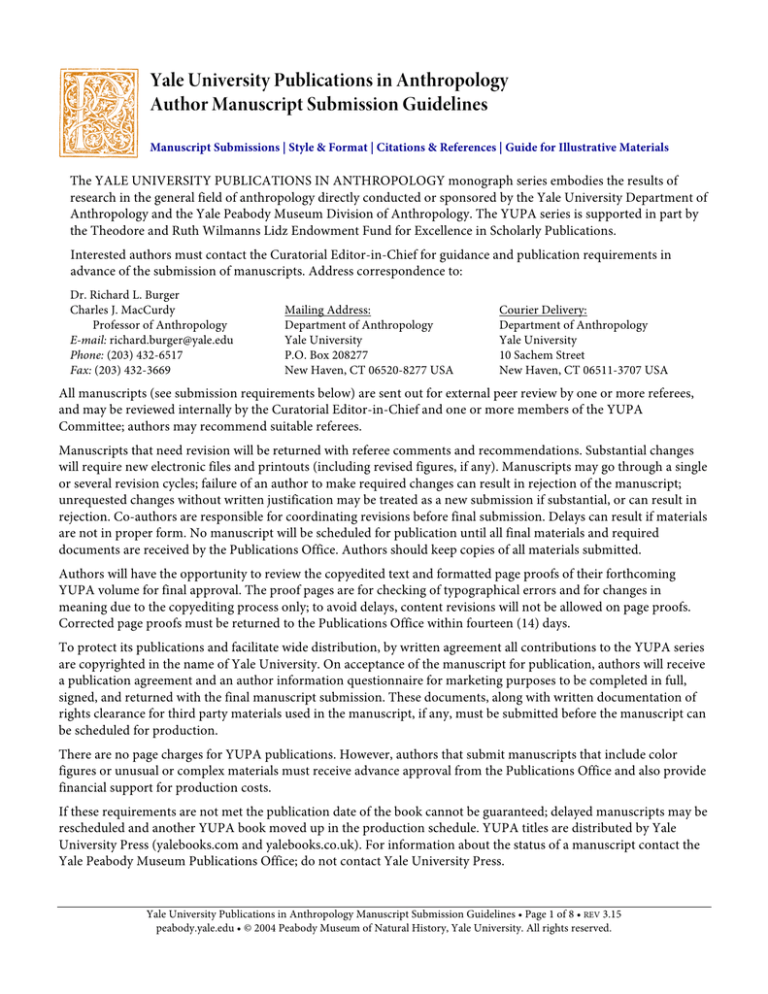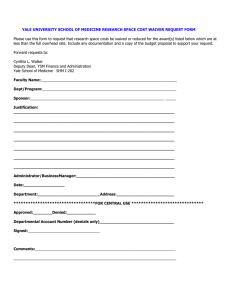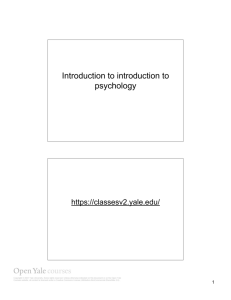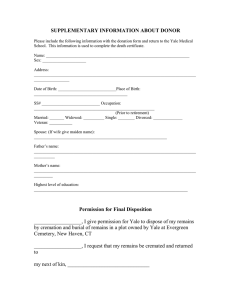
Yale University Publications in Anthropology
Author Manuscript Submission Guidelines
Manuscript Submissions | Style & Format | Citations & References | Guide for Illustrative Materials
The YALE UNIVERSITY PUBLICATIONS IN ANTHROPOLOGY monograph series embodies the results of
research in the general field of anthropology directly conducted or sponsored by the Yale University Department of
Anthropology and the Yale Peabody Museum Division of Anthropology. The YUPA series is supported in part by
the Theodore and Ruth Wilmanns Lidz Endowment Fund for Excellence in Scholarly Publications.
Interested authors must contact the Curatorial Editor-in-Chief for guidance and publication requirements in
advance of the submission of manuscripts. Address correspondence to:
Dr. Richard L. Burger
Charles J. MacCurdy
Professor of Anthropology
E-mail: richard.burger@yale.edu
Phone: (203) 432-6517
Fax: (203) 432-3669
Mailing Address:
Department of Anthropology
Yale University
P.O. Box 208277
New Haven, CT 06520-8277 USA
Courier Delivery:
Department of Anthropology
Yale University
10 Sachem Street
New Haven, CT 06511-3707 USA
All manuscripts (see submission requirements below) are sent out for external peer review by one or more referees,
and may be reviewed internally by the Curatorial Editor-in-Chief and one or more members of the YUPA
Committee; authors may recommend suitable referees.
Manuscripts that need revision will be returned with referee comments and recommendations. Substantial changes
will require new electronic files and printouts (including revised figures, if any). Manuscripts may go through a single
or several revision cycles; failure of an author to make required changes can result in rejection of the manuscript;
unrequested changes without written justification may be treated as a new submission if substantial, or can result in
rejection. Co-authors are responsible for coordinating revisions before final submission. Delays can result if materials
are not in proper form. No manuscript will be scheduled for publication until all final materials and required
documents are received by the Publications Office. Authors should keep copies of all materials submitted.
Authors will have the opportunity to review the copyedited text and formatted page proofs of their forthcoming
YUPA volume for final approval. The proof pages are for checking of typographical errors and for changes in
meaning due to the copyediting process only; to avoid delays, content revisions will not be allowed on page proofs.
Corrected page proofs must be returned to the Publications Office within fourteen (14) days.
To protect its publications and facilitate wide distribution, by written agreement all contributions to the YUPA series
are copyrighted in the name of Yale University. On acceptance of the manuscript for publication, authors will receive
a publication agreement and an author information questionnaire for marketing purposes to be completed in full,
signed, and returned with the final manuscript submission. These documents, along with written documentation of
rights clearance for third party materials used in the manuscript, if any, must be submitted before the manuscript can
be scheduled for production.
There are no page charges for YUPA publications. However, authors that submit manuscripts that include color
figures or unusual or complex materials must receive advance approval from the Publications Office and also provide
financial support for production costs.
If these requirements are not met the publication date of the book cannot be guaranteed; delayed manuscripts may be
rescheduled and another YUPA book moved up in the production schedule. YUPA titles are distributed by Yale
University Press (yalebooks.com and yalebooks.co.uk). For information about the status of a manuscript contact the
Yale Peabody Museum Publications Office; do not contact Yale University Press.
Yale University Publications in Anthropology Manuscript Submission Guidelines • Page 1 of 8 • REV 3.15
peabody.yale.edu • © 2004 Peabody Museum of Natural History, Yale University. All rights reserved.
Each author receives five (5) printed copies of their YUPA volume on publication, with the option to purchase
additional copies at a discount at the time of publication.
Manuscript Submissions
Submit manuscripts to the address above as follows:
•
All text as electronic files in a standard word processing format (MSWord preferred), with—
o
o
o
o
a separate file for each chapter or section (appendix, references, etc.);
each file named using the lead author’s name and by numbering files consecutively (e.g.,
jonespref.doc, jones1.doc, jones2.doc, jonesapp1.doc, jonesapp2.doc, jonesrefs.doc, etc.);
a separate text file for figure captions and a separate text file for table captions;
all tables as separate tab-delimited text files;
•
All figures (illustrations, photographs, maps, charts, mathematical formulas—NOT tables) as separate
electronic image files also named and numbered consecutively (e.g., jonesfig1.tif, jonesfig2.eps, jonesfig3.tif)
[See the “Guide for Illustrative Materials” below for file requirements.]
•
Two printouts of the entire manuscript, double-spaced with one-inch margins, on good quality 8.5" x 11"
white paper; these must match exactly the electronic files, including all figures and tables (do not embed
figures and tables in the body of the text);
•
Complete contact information (including email and mailing addresses) for all authors and contributors;
indicate the corresponding author who is to receive proofs and communications, and provide availability
during the academic year and in the field, as appropriate.
Electronic files may be submitted on disk, as attachments to e-mail (maximum size 20mb), or delivered using Yale
University’s cloud services or free file transfer facility (contact Publications for instructions).
Any resolution or compatibility issues for image files will be assessed during the review process. See below for
information on formats, or contact the Publications Office for guidance. Follow these guidelines carefully; delays may
result if materials are not in proper form. The Yale Peabody Museum Publications Office and the YUPA Committee
reserves the right to reject figures and manuscripts that do not conform to these requirements.
STYLE AND FORMATTING — Follow The Chicago Manual of Style, 16th ed. (ISBN 978-0226104201;
www.chicagomanualofstyle.org/) and Scientific Style and Format: The CBE Manual for Authors, Editors, and
Publishers, 7th ed. (ISBN 978-0977966509; www.councilscienceeditors.org/). See below for citation and reference
examples. The Publications Office reserves the right to adjust style and format to meet YUPA specifications.
TITLES — All monographs should be organized into titled chapters. Book titles should have a main title and a
subtitle. Titles, chapter titles, and all headings should be short, precise and straightforwardly descriptive, succinctly
conveying its content. Do not use abbreviations, acronyms, citations or hyphenated terms in titles.
TEXT — Write with precision, clarity and economy; use the active voice and first person. Main headings and all
subheadings should be explicit, descriptive, and as short as possible; hierarchical levels should be parallel and
consistent throughout the manuscript; do not use more than four levels of headings.
Citations may be organized by chapter as endnotes, or in text using the Chicago Author-Date system. See below for
guidelines on citations.
Keep formatting to a minimum; plain text is better. Do not use all capital letters anywhere. Italicize only as needed for
content (such as species names, non-English terms); do not underline. Point out any special characters, accents and
symbols; indicate by name any specialty fonts used in the manuscript.
Yale University Publications in Anthropology Manuscript Submission Guidelines • Page 2 of 8 • REV 3.15
peabody.yale.edu • © 2004 Peabody Museum of Natural History, Yale University. All rights reserved.
Avoid abbreviations and acronyms unless well established and widely used (for example, DNA). Less widely used
acronyms and abbreviations used more than a few times should be parenthetically defined at first use, otherwise spell
out the term. Avoid the excessive use of Latin terms.
Use numerals for all measurements given with units and for numbers and ordinals 10 and above. Give measurements
in metric and SI units (see http://www.bipm.org/en/measurement-units/); abbreviate units only for numerical
measurements, otherwise spell out the term. Use mathematical symbols only in formulas and tables, not as shorthand
in sentence structure.
CAPTIONS — All illustrations and photographs are to be called “Figures” and should be numbered consecutively
using Arabic numerals in the order of first mention in the text. Tables are numbered separately from figures. Do not
separate out “plates” from figures. Do not use multi-part figures or tables.
Captions are to provide all explanatory text for figures and tables. Each should be numbered and carry a short
introductory phrase or a formal title; do not place titles, explanatory text or footnotes in the figure itself and avoid
excessive wording. Size information may be included in the caption text or as visual scale bars in the figure.
Acknowledge sources for figures based on other work with “From Smith 2001” for work substantially reprinted as
first published, or with “Modified from Smith 2001” for work adapted from previously published material.
Credit for illustrations or photographs not by the author(s) must be provided for each figure, or listed in the
acknowledgments. Provide copyright information if you are not the copyright holder, along with a written statement
of permission to reproduce the material (see below).
Submit captions double-spaced in a clearly labeled separate electronic file (not attached to illustrations or tables),
with a separate paragraph devoted to each figure or table number.
FRONTMATTER — Provide a PREFACE by the author(s) discussing any background to the development of the
monograph that might be helpful to the reader, including any acknowledgments and permissions. Alternatively,
lengthy acknowledgements can be provided in a separate section following the preface. A FOREWORD—a statement
by someone other than the author(s)—is optional.
ACKNOWLEDGMENTS — Include information on granting agencies (provide grant numbers when available) and
on individuals and institutions that have lent or provided access to materials, financial support, field assistance or
editorial review, among others. Also include here the names of illustrators and photographers of work used that is not
by the author(s). Written permission to reproduce any copyrighted material must be submitted with the manuscript,
and proper credit included in figure captions or in the acknowledgments.
AUTHORSHIP — Authors named on manuscript submissions must have played a significant role in the research,
writing, and in the guidance of the research being reported. Those whose role involved providing materials,
specimens, financial support, field assistance or review should be recognized in the acknowledgments.
COPYRIGHT — All scholarly publications are copyrighted in the name of Yale University. To protect its
publications and facilitate wide distribution, contributors are asked to assign their copyright interests in their work in
writing to Yale University, including electronic rights. Authors in turn are granted the right to re-use their work
provided that all such use is for the personal noncommercial benefit of the author(s).
REFERENCES AND CITATIONS — For citations in the text and reference listings follow the guidelines and
examples for the author-date system given The Chicago Manual of Style (alternatively, the endnote system may be
used). Select examples are given below.
IN-TEXT CITATIONS — Unpublished material not available to researchers should be run into text or otherwise
cited in the text and not included in the reference list. Examples include manuscripts in preparation, private
correspondence (including e-mail), author observations and unpublished research; these should be cited as follows:
Yale University Publications in Anthropology Manuscript Submission Guidelines • Page 3 of 8 • REV 3.15
peabody.yale.edu • © 2004 Peabody Museum of Natural History, Yale University. All rights reserved.
(Smith, unpublished data)
(Smith, pers. obs.)
(Smith, pers. comm., 15 March 2003)
For materials in archives and manuscript collections, cite the specific item in the text (letter, typescript, etc.) and only
the author/collection and the depository in the reference list.
EATON, GEORGE F. 1912. Notes on Yale Peruvian Expedition. Yale Peruvian Expedition Papers, MS 664, box
19, folders 14–26; Manuscripts and Archives, Yale University Library.
PUBLIC ARCHIVES OF CANADA. Record Group 10 (Department of Indian Affairs). Library and Archives Canada,
Ottawa; http://collectionscanada.gc.ca
List in-text citations chronologically from earliest to latest; separate citations with a semicolon; citations in the same
year are listed alphabetically.
(Scudder 1889; Mayr 1963; Smith 1963; Jones and others 1985a, 1985b; Abrams 1989)
Where the author’s name is part of the sentence structure use:
Davis (1974)
otherwise use the format:
(Davis 1974)
Two or three authors:
Smith and Jones (1964a)
Curet, Rodríguez and Torres (2003)
More than three authors:
Jones and others (1977) or Jones et al. (1977)
Multiple authors in the same year, list as many authors as necessary to distinguish the citations.
(Gupta, Collinson et al. 2006)
(Gupta, Michels at al. 2006)
Citations for specific pages and figures should use the format:
Mayr (1963:236)
Mayr (1963, fig. 4)
Mayr (1963:236, fig. 4)
REFERENCE LISTS — Every citation in the text must be in the reference list, including references to websites,
databases, computer programs and other electronic resources. Provide URLs for all internet references, including
date of access, and availability information for hard-to-find sources. Do not use “Anonymous” for items without
authors; do not use ampersands.
Use sentence style capitalization for journal articles and parts of books; italicize and use upper/lowercase
capitalization style for book titles and journal names. Spell out journal names. Provide full names of all authors and
editors (use “and others” or et al. for names beyond the 10th). Provide full page ranges (153–175 not 153–75) and
volume and issue numbers for journal articles.
Book
ROUSE, IRVING. 1992. The Tainos: Rise and Decline of the People Who Greeted Columbus. New Haven: Yale
University Press. 211 pp.
Yale University Publications in Anthropology Manuscript Submission Guidelines • Page 4 of 8 • REV 3.15
peabody.yale.edu • © 2004 Peabody Museum of Natural History, Yale University. All rights reserved.
Book in a series
BURGER, RICHARD L. AND LUCY C. SALAZAR, eds. 2003. The 1912 Yale Peruvian Scientific Collections from
Machu Picchu: Human and Animal Remains. New Haven: Yale University, Department of Anthropology
and Peabody Museum of Natural History. 181 pp. (Yale University Publications in Anthropology 85.)
Book chapter (multivolume work)
REYNOLDS, BARRIE. 1978. Beothuk. In: Bruce Trigger, ed. William Sturtevant, gen. ed. Handbook of North
American Indians. Volume 15, Northeast. Washington, DC: Smithsonian Institution. pp. 101-108.
Book chapter (series)
MILLER, GEORGE R. 2003. Food for the dead, tools for the afterlife: zooarchaeology at Machu Picchu. In:
Richard L. Burger and Lucy C. Salazar, eds. The 1912 Yale Peruvian Scientific Collections from Machu
Picchu: Human and Animal Remains. New Haven: Department of Anthropology, Yale University, and
Peabody Museum of Natural History. pp. 1–63. (Yale University Publications in Anthropology 85.)
Computer program
SWOFFORD, D. L. 1999. PAUP* (phylogenetic analysis using parsimony [*and other methods]) [computer
program]. Version 4.0b2a. Sunderland, MA: Sinaurer.
[ESRI] ENVIRONMENTAL SYSTEMS RESEARCH INSTITUTE. 2006. ArcGIS® Spatial Analyst, Version 9.2
[computer program]. ArcGIS® Desktop Extension. Redlands, CA: ESRI. Available from:
http://www.esri.com/software/arcgis/extensions/spatialanalyst/index.html
Conference abstract
MCKINNEY, KEVIN C., WILLIAM A. COBBAN AND NGUYET T. PHAN. 2003. GIS application of the newly
digitized USGS–Denver Cretaceous fossil mollusk collection [abstract]. In: Geological Society of America
Abstracts with Programs 35(6) [internet]. Annual Meeting of the Geological Society of America; 2003 Nov
2–5; Seattle, WA. [Boulder, CO]: GSA. p. 278. [updated 2005 March 3; cited 2006 April 19]. Available
from: http://gsa.confex.com/gsa/2003AM/finalprogram/abstract_61482.htm
Conference proceedings
DAVIS, DAVE D. 1974. Some notes concerning the Archaic occupation of Antigua. In: Ripley P. Bullen, ed.
Proceedings of the 5th International Congress for the Study of Pre-Columbian Cultures of the Lesser Antilles;
1973 Jul 22–28; Antigua. Gainesville, FL: Florida Museum of Natural History. pp. 65–71.
Conference presentation (if not publicly available place in text only, not in reference list)
PASTORE, RALPH T. 1977. The Mic-Mac colonization of Newfoundland; paper presented at the annual
meeting of the Canadian Historical Association, 1977. 21 pp. Available from: Mi’kmaq Holdings Resource
Guide, Nova Scotia Archives and Records Management Library, Halifax, NS;
http://www.gov.ns.ca/nsarm/library/
Dissertation or thesis
BILLMAN, BRIAN R. 1996. “The Evolution of Prehistoric Political Organizations in the Moche Valley,
Peru” [dissertation]. Santa Barbara. CA: University of California–Santa Barbara, Department of
Anthropology. 385 pp. Available from: ProQuest Dissertations & Theses [database online];
http://www.proquest.com (publication AAT 9708060).
CZWARNO, R. MICHAEL. 1983. “Ceramic Indications of Cultural Interaction: Evidence from Northern
Peru” [master’s thesis]. Peterborough, ON, Canada: Trent University, Department of Anthropology. 247
pp.
Yale University Publications in Anthropology Manuscript Submission Guidelines • Page 5 of 8 • REV 3.15
peabody.yale.edu • © 2004 Peabody Museum of Natural History, Yale University. All rights reserved.
Internet article
JABLONSKI, NINA 2004. Putting technology to work at Koobi Fora. KFRP Field Season Dispatches [internet].
Kenya: Koobi Fora Research Project; [cited 19 April 2006]. Available from:
http://www.kfrp.com/dispatches_2004/gis_jablonski/gis_jablonski.htm
Internet web page
MI’KMAQ RESOURCE CENTRE. 1998. Ethnographies [internet]. Sydney, NS, Canada: University College of Cape
Breton. [updated 1998 Oct 27; accessed 2000 Dec 6]. Available from:
http://www.uccb.ns.ca/mikmaq/ethnog.html
Internet database
[ePic] ELECTRONIC PLANT INFORMATION CENTRE [internet database]. 2002. Richmond, England: Royal
Botanic Gardens, Kew. [updated 2003 Jan 27; accessed 28 Mar 2003]. Available from:
http://www.kew.org/epic/
THE TREE REGISTER [internet database]. 2006. Bedford, England: The Register. c2006. [updated 2006 Jan 27;
accessed 6 Apr 2006]. Available from: http://www.tree-register.org/
Journal article
DAVIS, DAVE D. AND R. CHRISTOPHER GOODWIN. 1990. “Island Carib origins: evidence and non-evidence.”
American Antiquity 55(1):37–49.
Journal
JOURNAL OF LEGAL PLURALISM AND UNOFFICIAL LAW. Birmingham, UK: Foundation for the Journal of Legal
Pluralism, in association with the African Studies Center, University of California, Los Angeles. Vol. 1, 1969–
Available from: http://www.jlp.bham.ac.uk/
Map
CARTA DE LA REPÚBLICA DE CUBA [map]. 1933. Washington, DC: US Army, Engineer Reproduction Plant. 2
sheets: black and white, scale 1:500,000. Available from: The Map Collection, Sterling Memorial Library, Yale
University.
Newspaper article (add edition, section and page number if known)
ZIELBAUER, PAUL. 2001 Jan 19. “Attorney general sues to halt US recognition of 2 tribes.” New York Times.
WILFORD, J. N. 1986 Aug 14. “Texas fossil may be bird’s oldest ancestor.” New York Times; Sect. A:1(col. 1).
Newspaper article (unsigned; start with title)
NEW FACTFINDER TO ADVISE ON FIRST NATIONS MATRIMONIAL PROPERTY RIGHTS. 1998 Sept. Mi’kmaqMaliseet Nations News 9(9):5. Truro, NS, Canada: The Confederacy of Mainland Mi’kmaq/Eastern
Woodlands Publishing.
News article (online)
CBC NEWS. 1999. “Mi’kmaq claims parcel of Eskasoni land is his” [online news service]. Toronto: Canadian
Broadcasting Corporation. [updated 1999 Aug 3; accessed 23 Jun 2005]. Available from:
http://www.cbc.ca/news/story/1999/08/03/nsdenny030899.html
Yale University Publications in Anthropology Manuscript Submission Guidelines • Page 6 of 8 • REV 3.15
peabody.yale.edu • © 2004 Peabody Museum of Natural History, Yale University. All rights reserved.
Yale University Publications in Anthropology
Author Manuscript Submission Guidelines
Guidelines for Illustrative Materials
Authors who supply their own digital files are responsible for providing images with resolution of acceptable quality.
Only high resolution images will produce high quality print reproductions. Contact the Yale Peabody Museum
Publications Manager with any questions at peabody.publications@yale.edu or 1-(203)-432-9804.
TABLES — Submit tables as separate electronic tab-delimited word processing files. Tabular material should be typed
separately, one to a page, placed following the main text and numbered consecutively using Arabic numerals. Do not
submit multi-part tables. As with figures, indicate the approximate desired position in the text with marginal notes.
Do not use vertical lines or vertical writing, or all capital letters. Do not submit tables as image files.
FIGURES — All illustrations and photographs are to be provided at the time of submission as electronic files and
prepared to professional standards. Size figures at just above 1:1 reproduction size to fit the width of the publication
(6 inches; 15 centimeters; 33 picas). Do not submit multi-part figures.
Figures will be evaluated for suitability for publication and a checklist of any technical improvements needed
provided when manuscripts are returned with reviewer comments. All final figures must be submitted with the final
revised manuscript and must meet the technical requirements of this checklist.
All illustrations and photographs are to be called “Figures”; numbered consecutively using Arabic numerals. Use bold
uppercase sans serif letters (Helvetica or Arial) for labels; be consistent in the use of labels throughout the
manuscript. Authors may indicate the approximate desired position for figures in the text, but exact placement
cannot be guaranteed; figures will be placed as close as possible to first mention as practical.
Figures (and tables) should be planned for “portrait” reproduction rather than “landscape”; no figure or table will be
published larger than page size, as a tip-in, insert or fold-out. Scale bars must appear on illustrations, photographs
and maps; alternatively, magnification values can be given in the accompanying caption text. Do not include the
figure number or title as part of the figure itself; these should be placed in the caption, along with any definitions for
any abbreviations, symbols or labels. Do not use all capital letters for headings or titles.
For guidance on creating figures and tables, see The Chicago Manual of Style, 16th ed. and Scientific Style and Format:
The CBE Manual for Authors, Editors, and Publishers, 7th ed.
Submitted figures as high resolution electronic TIF or EPS files, as follows:
Black-and-white halftone/grayscale photographs
• Required minimum resolution is 300 ppi at 1:1 reproduction; maximum resolution is 600 ppi
• 256 grays (8-bit grayscale TIF)
• Minimum width 6 inches (2100 pixels)
Black-and-white line illustrations submitted as raster images (e.g., Photoshop® files)
• Required resolution is 1200 ppi at 1:1 reproduction
• Save file as bitmapped (grayscale) TIFs (to reduce file size)
• Minimum width 3 inches (1100 pixels) for single column, 6 inches (2100 pixels) for double column
Yale University Publications in Anthropology Manuscript Submission Guidelines • Page 7 of 8 • REV 3.15
peabody.yale.edu • © 2004 Peabody Museum of Natural History, Yale University. All rights reserved.
Color figures
• Required minimum resolution is 300 ppi at 1:1 reproduction; maximum resolution is 600 ppi
• Save file as RGB 24-bit or CMYK
• Minimum width 3 inches (1100 pixels) for single column, 6 inches (2100 pixels) for double column
Combination files (continuous tone screens or grayscale images in combination with type or line drawings):
• Files created in Adobe® Photoshop® must have a minimum resolution of 600 ppi at 1:1 reproduction size;
however, a resolution of 800 dpi will give better results
• Files created in Adobe® Illustrator® that include halftone images must have all images embedded (not linked);
these placed images must also follow the resolution requirements above to ensure quality reproduction. All
fonts must be converted to outlines.
Original files created in vector programs such as Adobe® Illustrator® are also acceptable. Figures created from
specialized software should be exported as EPS or TIF files for print publication as recommended by the software
maker. Labels, symbols and icons should be large enough to be readable at reproduction size.
Charts and illustrations created in Microsoft Excel® and other Microsoft Office® programs are unusable and will NOT
be accepted. Do not submit final images as a figure placed into a Microsoft document.
Do not submit images downloaded from web pages. (For permissions on Google® images and maps see
http://www.google.com/permissions/index.html. Google® images without the proper attribution and file resolution
will not be accepted.)
Photographs from digital cameras should be taken at the highest resolution setting and size available, preferably as
TIF images. Submit original camera images; do not resave photographs in a compressed format (such as JPG).
See also:
Cadmus Digital Art Support
ESRI’s ArcGIS Software
Adobe TV How-To
Printernational
http://art.cadmus.com/da/index.jsp
http://mappingcenter.esri.com/index.cfm?fa=home.welcome
http://tv.adobe.com/channel/how-to/
http://www.printernational.org/
PERMISSIONS — Contributors using previously published material to which they do not have copyright (for text,
photography and illustrations) are responsible for obtaining, at their own expense, the required written permission to
re-use such material, and for submitting this documentation with the manuscript for review by the Yale Peabody
Museum, to be kept on file in the Publications Office. The appropriate credit lines must be included with the
manuscript.
Contributors should note that copyright rests with the creator of any text, illustration or photograph unless
transferred in writing or created as a work-for-hire, and should obtain the necessary permissions as required. For
more information on copyright see the U.S. Copyright Office web pages at http://www.copyright.gov/.
Yale University Publications in Anthropology Manuscript Submission Guidelines • Page 8 of 8 • REV 3.15
peabody.yale.edu • © 2004 Peabody Museum of Natural History, Yale University. All rights reserved.




